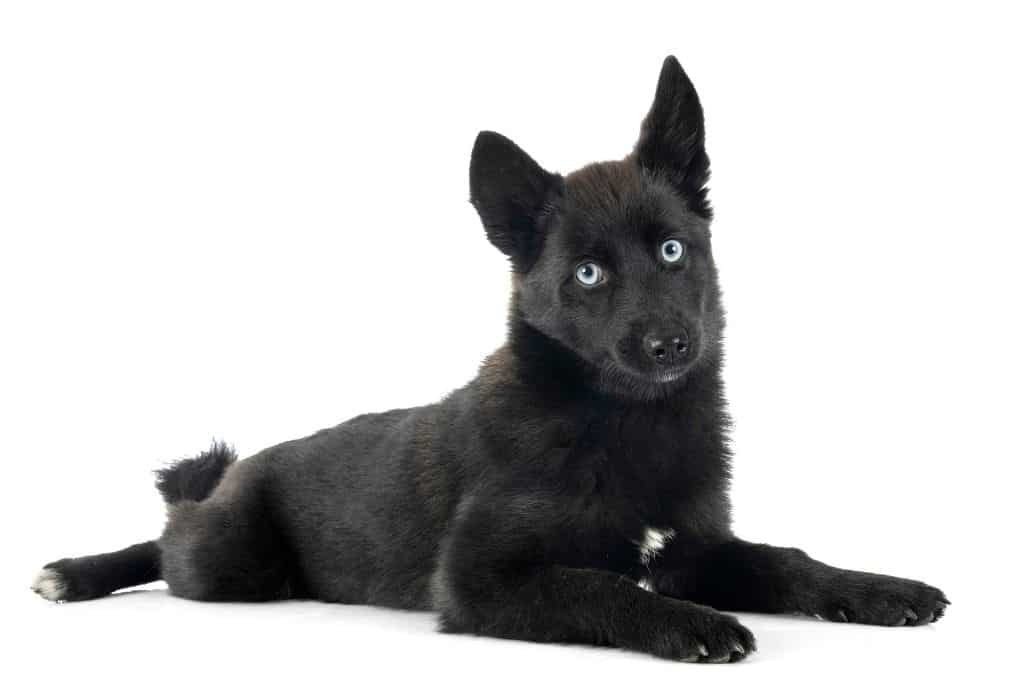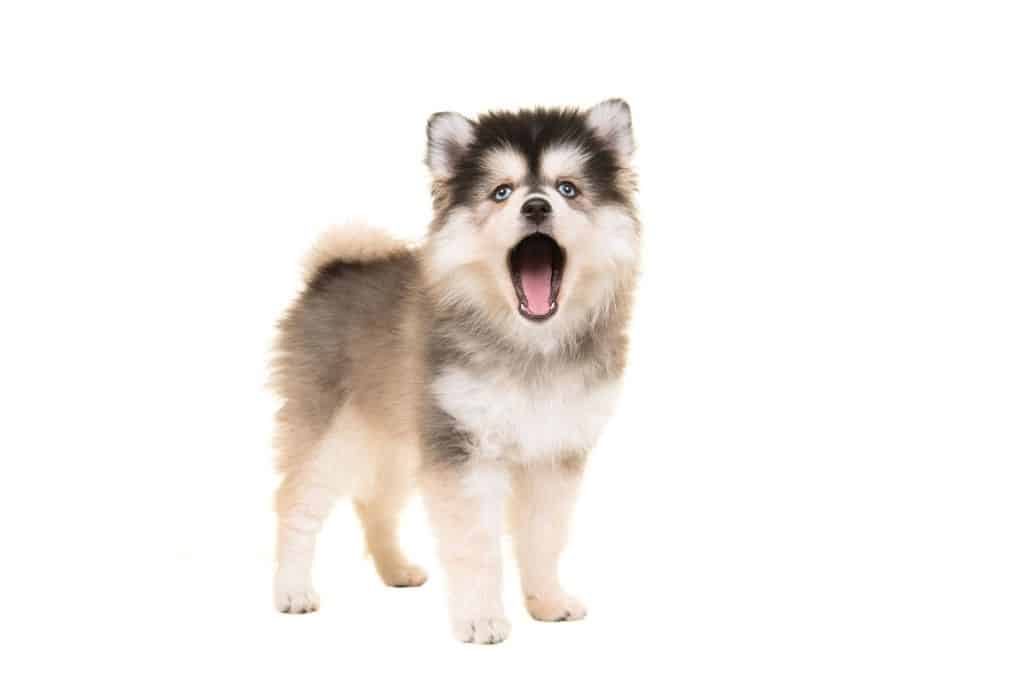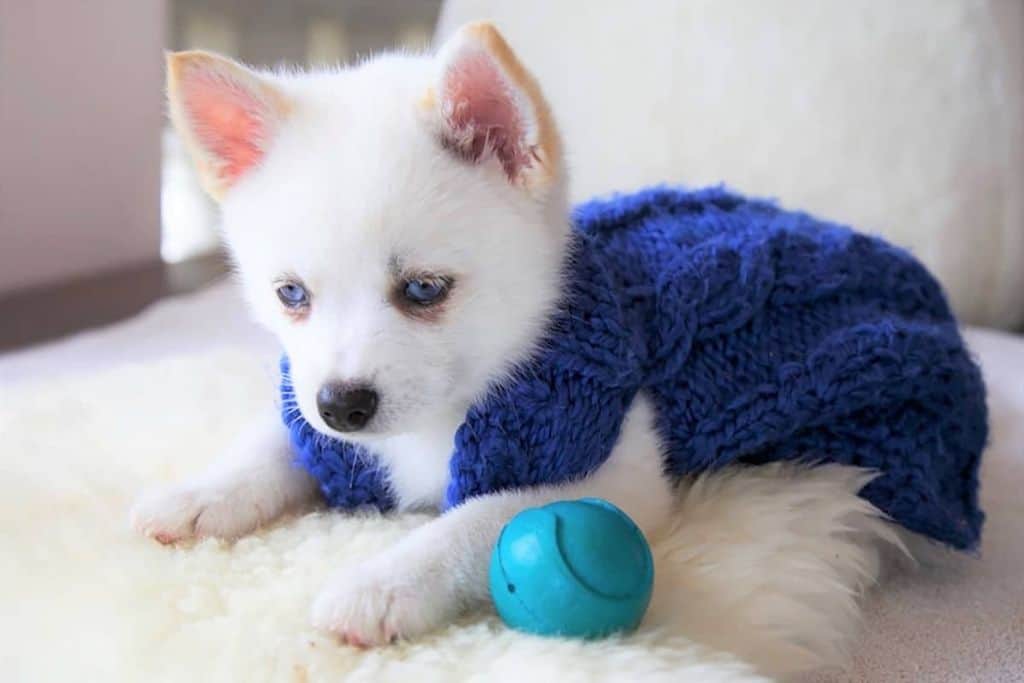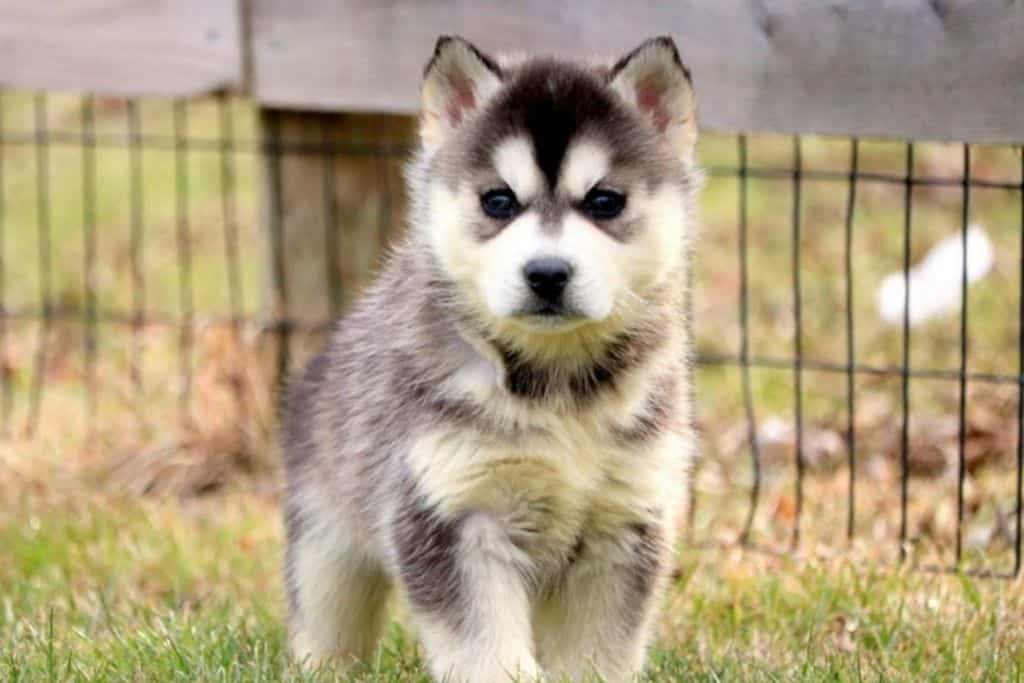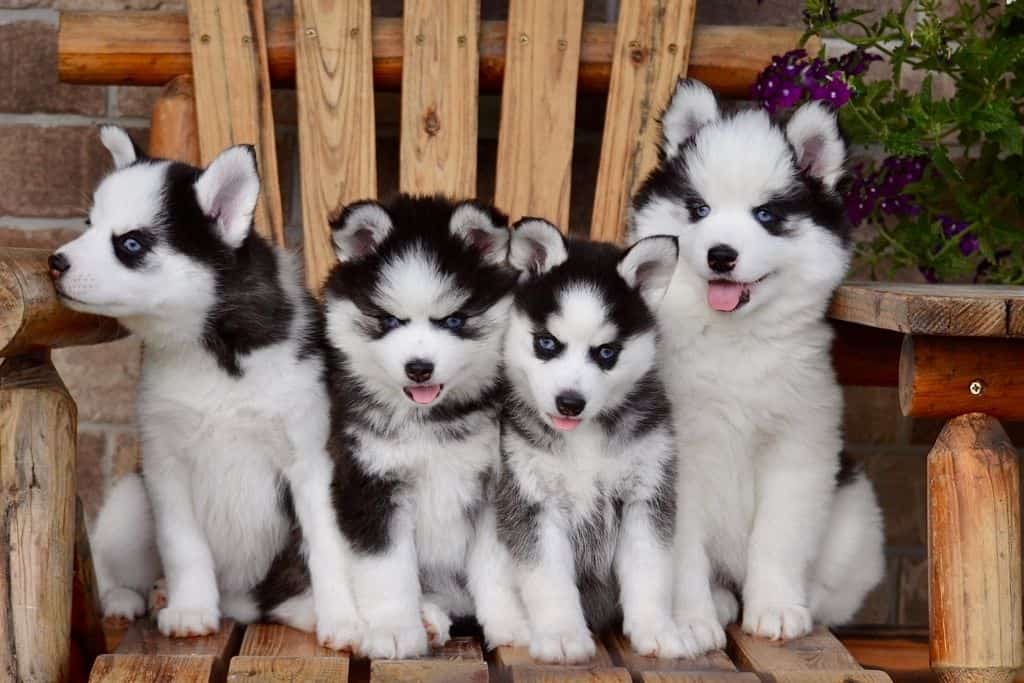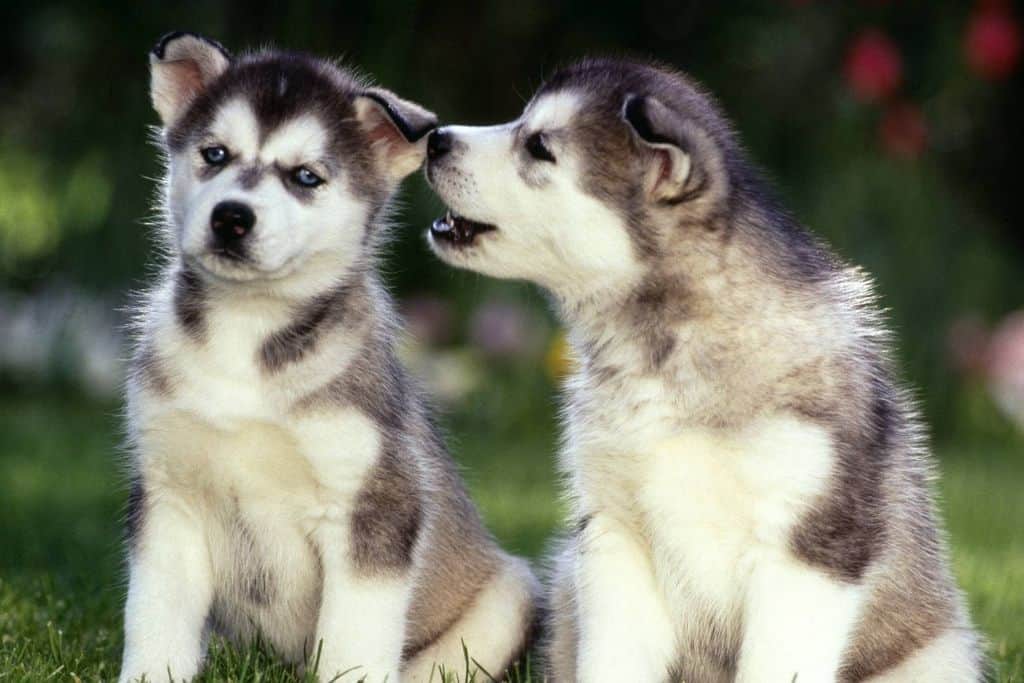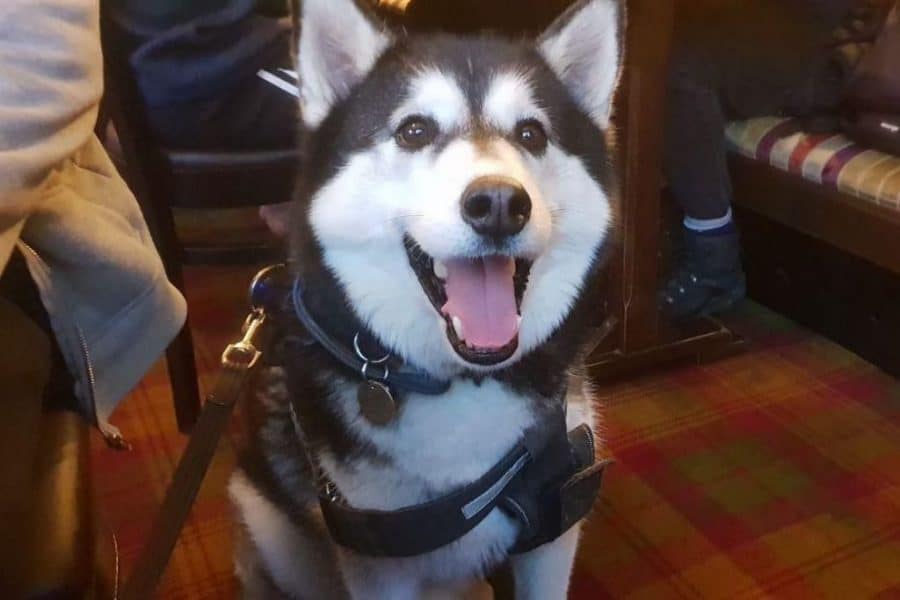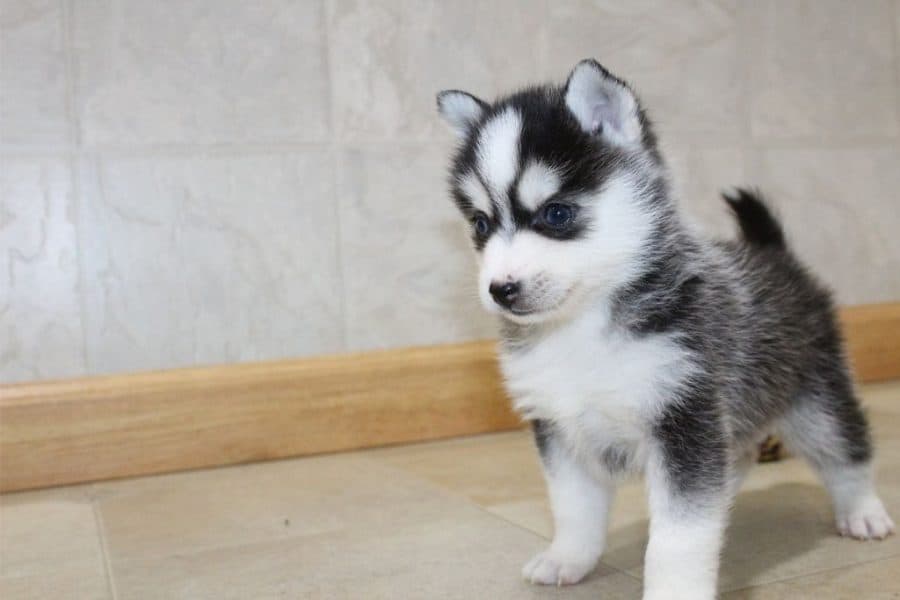They say “big things come in small packages” and that’s true for the Pomsky!
Even being small in size, they are loaded with high energy and intelligence.
Pomsky is a cross between Pomeranian and Husky that looks like an adorable version of a miniature husky.
It is one of the designer dog breeds that has recently gained popularity.
All hail to their photogenic looks and an overload of cuteness.
*Bows Down to the little King*
This little clown is a family-friendly dog that loves to get attention and often pleases its owner with its playful nature. Its tiny body makes them ideal for apartments and small living spaces, as long as they’re provided with plenty of play and comfort from its Hooman.
Keeping Pomsky sounds cool, but is it a perfect breed for you?
Spend the next few minutes to find out!
Fun FACt: Pomsky breed can fall victim to ‘Small Dog Syndrome’ where they believe that they are superior to their masters. To avoid turning them into bandit, Pomsky dogs should be trained from an early age.
Table of Contents
Breed Images
Quick Facts
Average Weight: 7 to 38 Pounds
Average Height:10 to15 inches
Dog Group: Mix breed dog
AKC Rank: Not recognized.
At A Glance
Pomsky size is small to medium with an average height that can fall between 10 and 15 inches. Their weight can go from 7 pounds to 38 pounds on average. Their built falls in the range of their parent husky and pomeranian’s size As the breed is relatively new, breed standards are not established for this little one. The lifespan of a Pomsky is about 12 to 15 years. Contrary to the belief that all small dogs are well suited for apartment living, there are plenty of small dog breeds that have high energy levels. This can make a small breed dog not suitable for apartment living. But, the Pomsky breed is a tiny dog breed that can easily live in apartments and small living spaces. The only care that should be taken is that they get plenty of exercise and walks. Pomsky is a playful and brilliant family dog. It has the qualities of an attention seeker and loves to be around family members. Pomsky can have instincts of hunting, passed down from their parent husky. This trait can make them less pet-friendly. Care must be taken with smaller pets like cats, birds, hamsters as they may attack them. Still, this trait is subjective with each pomsky. Having a chatty doggo can be problematic if you’re living in an apartment. Both parents - Pomeranian and Husky have high barking tendencies which make their offsprings highly vocal. Pomskies may also show a habit of barking excessively, if not trained from the first day. Pomskies have a high tolerance to cold weather due to their thick coat, just like their wolfy parent. Having a thick coat makes them intolerant to warm and hot climates which can result in overheating. Make sure to keep pomskies cool during hot weather. The Pomsky is a clever and intelligent breed. Thanks to their parents! The combination of Pomeranian and Husky makes Pomsky a trainable breed; yet, the husky genes may manifest more making this little furball stubborn. But this trait can be overcome if the pomskies are trained from an early age. Pomskies are power-packed with energy and need about an hour of daily exercise and walk to stay healthy. They may get bored and show excessive barking, howling, and chewing habits if not exercised properly. Pomsky grooming can be a daunting task as this breed is prone to shedding excessively. They have a double coat that needs to be brushed daily to avoid mat and tangled hair. Nails can be cut every few weeks, but Pomskies require everyday teeth brushing as they are prone to dental problems. They shed like crazy which is one of the reasons why Pomskies are not hypoallergenic. This means that they do carry allergens that will produce an allergic reaction in humans. Pomsky price can range between $1000 and $5000
Being a designer dog breed, they are bred using artificial insemination which makes them one of the costliest breeds.
Attention! DogIsWorld does not promote buying of dogs. The price column given here is for reader’s convenience. We strongly support the idea of rescuing and adopting dogs.
About
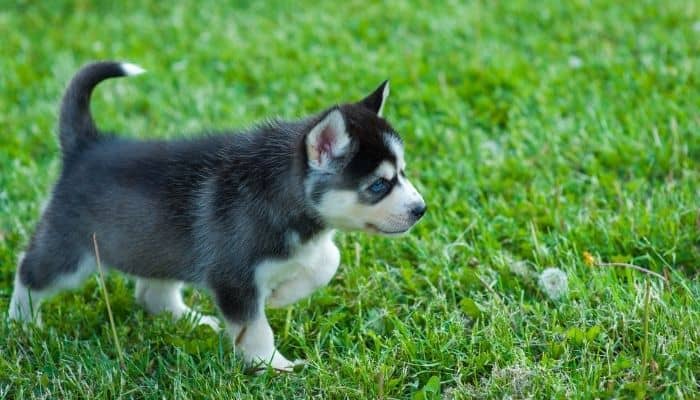
Pomsky is a family-friendly, social, and tiny dog breed. They are loyal, intelligent, and smart. Their weight can fall between 7 and 38 pounds with a height that goes 10 to15 inches at withers, but they are small enough to cuddle up in your lap!
This dog breed is relatively new which is said to have originated somewhere around 2009 in the United States. As Pomskies are mixed-breed dogs, there’s no established breed standard for appearance or temperament, and it can be impossible to predict which parent trait will be dominant in the puppies.
For the most part, Pomskies look similar to miniature wolves or small huskies but some may resemble their other parent – Pomeranians. Even the puppies born to the same litter may vary widely from each other, with some resembling huskies and others like Pomeranian.
The Lifespan of a Pomsky is estimated to be about 12 to 15 years considering the lifespan of both of their parents – Husky with 12-15 years and Pomeranian with 12-16 years.
The temperament of a Pomsky can also widely differ. Usually, they inherit desirable traits from both of their parents which include high intelligence, a loving and playful nature, and family-friendly traits.
Due to the size difference of the parent dogs, natural breeding is difficult and so Pomskies are always bred by Artificial insemination. To avoid complications, the surrogate mother is always Husky because of their large size as compared to Pomeranian.
Artificial insemination is an expensive process, and so the breeders charge a lot of money for Pomskies. Another way is to adopt a dog! You can visit Petfinder or other genuine websites to adopt one for yourself.
Still not sure? Read our Guide To Finding A Dog Breeder
History
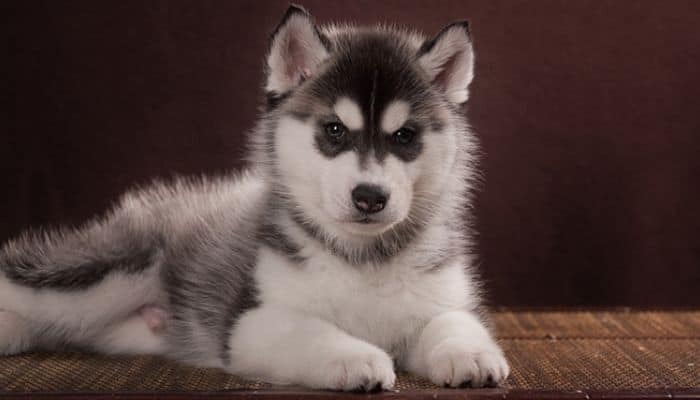
The Pomsky breed is relatively new in the era. Their History is not long as they are said to have originated somewhere around 2009 in the United States.
The first record of Pomsky came into existence in March 2012 when two friends in Arizona – Tressa Peterson, and Joline Phillips executed the “Pomsky plan”. The Pomsky litter was created with Pomeranian sire and Siberian Husky Dam.
The Pomsky breed is a designer breed created through artificial insemination where the surrogate mother is always a husky and the sperm donor is a pomeranian.
Since the breed is so new, most standards of their traits are not established yet and it can take more years and generations before establishing standards.
The Pomsky Club of America is an organization working to get the Pomsky breed officially recognized.
At present, Pomskies can vary greatly in looks and personalities, even within the same litter, so establishing breed standards will take time.
Facts Theatre
The Pomsky puppies have attracted a lot of attention from netizens recently and became one of the most popular dog breeds of 2017.
Pomskies are adaptive learners and highly intelligent. They can learn tricks with ease.
Pomsky loves to dig. If they get bored, they can find ‘digging’ a way to escape boredom!
All dogs are at risk of some heart conditions if not fed and trained properly. When it comes to Pomskies, they can develop Dilated Cardiomyopathy.
Parenting Guide And Care

Even being tiny, Pomskies can have a lot of energy and may need about an hour of daily exercise & play to stay fit and beat boredom. In most cases, their exercise needs can be met with at least one good walk per day.
Pomskies inherit thick coats from their Parent husky, making them tolerant to cold weather. On the downside, they are prone to overheating in warm weather.
Solution: Keep your AC running during summers and give your little boi cold treats! Plus read our blog on How To Keep Dogs Cool In The Summer.
Pomsky is an intelligent breed that needs to be stimulated mentally. Give your little cuddle partner enough toys to play with as they can become bored if not challenged, and boredom can lead to ‘bad boi’ behaviors like excessive barking, howling, and chewing habits.
Training with Pomskies can be a daunting task as some can inherit stubbornness from their parent Husky.
Husky genes activated!
But, this can be overcome if they are provided with food motivators and plenty of praise. Also training your Pomsky puppy from an early age is a must.
Remember, positive reinforcement (without punishment) is the key to a happy and obedient Pomsky.
Personality And Temperament

The Pomsky temperament has a dash of both – comedy and intelligence. They will perform cute antics to get admiration from their hooman. They are highly adaptive and can live in apartments and small-spaced rooms, considering they get enough exercise.
Pomskies can inherit vocal traits from their husky parent, which can turn them into a chatterbox. They may show howling tendencies which can cause problems to the neighbors.
But why do they howl? You can check it here.
Pomskies are attention seekers and love getting praised. They often get deeply attached to one family member, although they bond with other members as well.
They must be socialized and trained from early puppyhood, failing which they may become anxious around strangers and show aggression toward other animals.
Pomsky can show high prey drive which can make them less pet-friendly. This is due to the fact that they have instincts of hunting which is passed down from their parent husky.
They may chase and attack smaller pets like cats, birds, hamsters, and other toy dogs as well.
This trait can be curbed if they are introduced to other pets from an early age.
“Husky genes: under control!”
Care must be taken with smaller pets as Pomskies may attack them. However, this trait is subjective with each pomsky.
The puppies can show stubbornness while training (Yes, you guessed it right- the husky genes), but this can be curbed with positive reinforcement and little perseverance in training from their human companion.
Colors And Grooming
Pomsky’s appearance cannot be always predicted! Some pomskies can show more relevance to either of its parents!
If two of the same F1 pomsky are bred to one another, the outcome of F2 pomsky can be even more varied. This is the reason why Pomsky breeders stick to create a fresh F1 cross with each mating.
Pomskies have a fluffy double coat that keeps them comfortable in cold weather. Their coat requires a lot of brushing to maintain the texture.
Brush Brush Brush!
This little wolf sheds a ton, leaving its hair everywhere even after grooming. The best is to keep lint rollers and a vacuum cleaner handy.
Pomskies can be bathed once every 1-3 months, and during summers- once every month. During cold temperatures, the frequency of bathing should be minimized. Read our guide on bathing a dog.
Nails can be trimmed every few weeks, but brushing should be done every single day as they are prone to dental problems.
Also read: Dental Care for Dogs
Feeding

Feeding the right amount of food to your dog, along with high quality is an essential part of being a dog-parent. Feeding is subjective to the type of dog food used, whether it’s dry or wet. It also varies with age, weight, the activity level or your dog and so on.
Providing your doggy with the best food will make their body perform at a high level as they need a balance of protein, fats, and carbs. The ratio of these components can be estimated approximately to 30% protein, 30% fat, and 40% carbohydrates.
Wait!
There’s more.
It is important to avoid toxic food in the Pomskies’ diet. Take a look at a list of toxic food to avoid.
Puppy: 2 weeks to 1 year
Having a Pomsky puppy, it is vital to understand the dietary needs of both sides of the breed as they’re half Pomeranian and half Husky. According to the Association of American Feed Control Officials (AAFCO), puppies need a protein content of at least 22%.
Most dog owners feed their dogs once or twice a day, but it is recommended to feed your puppy 3 or 4 times per day for their proper growth.
Initially they must be fed soft, canned food. As soon as they are old enough to munch hard kibble, the canned food should be discontinued.
Take a look at our complete guide to feed puppies
Adult: 1 to 8 years
After the age of 1 year, the adult Pomsky diet should be transitioned from canned soft food to an adult formula.
AAFCO recommends that the minimum requirement of protein for adult dogs should be at least 18%.
But the more, the better!
The big (yet tiny) dog diet should be balanced with 20% protein and 6% fat from high-quality animal sources. They can be switched to hard kibble and other available dog food. You can also feed them homemade dog food.
What? You don’t know how to make dog food at home?
Don’t worry. We’ve got you covered with our Perfect Guide To Homemade Dog Food!
Senior: 8 years and above
The metabolism slows down as dogs get older. Around 8-10 years of age, Pomsky can become weak and will need different nutritional requirements to stay healthy. Adding extra vitamins and minerals to their diet will work as a bonus for their immunity.
At this point, Pomsky should be switched to a food that has less protein and fat to avoid overweight and other health issues. Also, customizing the diet according to the dog’s level of activity would be the best choice.
We also have a Guide to Senior dog food. Great isn’t it?
Health and Vaccination

Both the Siberian Husky and Pomeranian are healthy breeds and do not have any breed-related health issues; but as Pomsky is a designer breed, they may inherit the issues of both dogs that can range from mild to severe.
Heart Diseases
Heart diseases are common in dogs with no exercise and unhealthy food habits. Pomskies are at risk of Dilated Cardiomyopathy – an enlarged heart due to certain ventricles not functioning correctly. The symptoms appear during adulthood and include coughing, wheezing, loss of appetite, weakness, or any changes in behavior.
Patellar Luxation
Patellar Luxation is a condition where the kneecap slips out of the joint. This happens frequently and is a common problem in many dog breeds. It may cause no pain or sometimes you may hear your dog whining in pain. The indication of Patellar Luxation is your dog limping with one paw in the air.
Collapsing Trachea
Collapsing Trachea is common in small dog breeds like Pomeranian. It can also affect Pomskies as they are half pomeranian. This usually happens when the dog struggles to run in the opposite direction with a neck leash which puts stress on the neck. The small rings of bronchial tube rings become weak and eventually degrade, narrowing the trachea. This causes difficulty in breathing and low quality of life for Pomsky.
A precautionary measure can be adopted to avoid this mishap: use of harness leash instead of a neck leash.
Corneal Dystrophy
The cornea develops an opacity that prevents Pomsky from seeing correctly. This disorder is passed on by parent Siberian Husky (the Husky genes again in action!)
This condition is usually harmless as there is no pain or discomfort involved. But it may progress to corneal ulceration which could result in vision loss.
Legg-Calve-Perthes Disease
Legg-Calve-Perthes Disease happens due to degeneration of the thigh bone and results in the entire hip joint becoming weak and eventually breaking down as well.
It can cause swelling in the hip region which can be served as a good indicator of Legg-Calve-Perthes Disease.
At the age of 5 weeks, Pomsky puppies should be given a Parvovirus shot as they are at high risk of exposure to parvo.
Pomsky should be vaccinated with canine parvovirus and for canine distemper at 6, 8, 10, 12, and 16 weeks of age and then a booster every three years.
Make sure to also get a deworming vaccination plan for your pooch from your vet.
Confused about vaccination? You can take a look at our detailed beginner’s guide on Dog Vaccination
A point to remember: The vaccination should be done under the guidance of a veterinarian, and the vaccination schedule can be altered as per the requirement.
Frequently Asked Questions
Pomsky is a designer dog breed that is a cross between a pomeranian and Siberian husky. It is a small to medium-sized dog breed with a height ranging from 0.8 to 1.25 feet. They are bred by artificial insemination. Pomsky can get 10- 15 inches in height and 7 to 38 pounds in weight. Pomskies are known to shed a lot. This is due to the trait they inherit from their both parents- Pomeranian and Husky, who are heavy shedder. Pomsky cost can range anywhere between 1000$ and 5000$ depending upon the quality of breed, lineage of parents and other contributing factors. They are an expensive dog breed as they are reproduced by only means of artificial insemination. Just like their parents, the Pomsky lifespan falls between 12 and 15 years. Adult Pomsky is referred to as a puppy that has gone into adulthood. They become an adult at the age of one year. Pomskies come with a lot of variation in their coat color which includes pied, fawn, grey, brown, cream, and white coat. Pomsky white is used to refer to a pomsky with a white coat. Teacup dogs are dog breeds that have been bred to be as small as possible. According to American Kennel Club, their weight range is 2-5 pounds and height less than 17 inches. Teacup Pomsky is the smallest variety of this dog breed.
Similar dog breed:
Hey reader,
Thanks for reading! The information on this article is limited as this dog breed is a new one. But don’t worry, we have dug up the whole internet for providing you the genuine details on this breed.
If you own a Pomsky, do let us know your experience with your little fur ball in comment section.
You can also reach out to us on Instagram and Facebook.
You can binge-watch our youtube videos to learn more about Dog culture.
We at DogIsWorld are trying to guide every dog parent with useful content so that they can take care of their pet with utmost care.
Happy Petting To You Guys!





